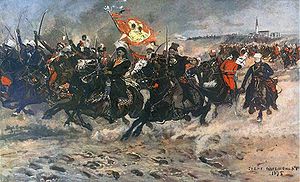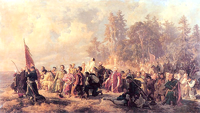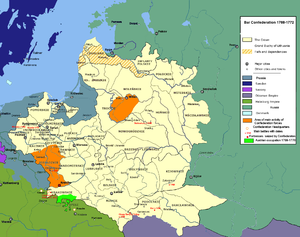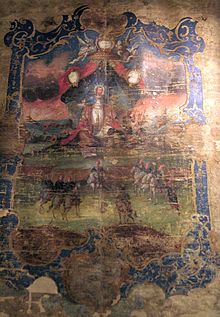- Bar Confederation
-
War of the Bar Confederation Part of Russo-Turkish War (1768–1774)
The Bar Confederates pray before the Battle of Lanckorona. Painting by Artur Grottger.Date 1768-1772 Location Poland Result Russian Victory Belligerents  Russian Empire
Russian Empire Kingdom of France
Kingdom of France
 Bar Confederation
Bar ConfederationCommanders and leaders  Alexander Suvorov
Alexander Suvorov
 Ivan Karpovich Elmt
Ivan Karpovich Elmt Charles François Dumouriez
Charles François Dumouriez
 Ignacy Malczewski
Ignacy Malczewski
 Michał Jan Pac
Michał Jan Pac
 Karol Radziwill
Karol Radziwill
 Casimir Pulaski
Casimir PulaskiStrength Lanckorona: 4,000 troops Lanckorona: 1,300 troops; 18 cannons Casualties and losses unknown heavy War of the Bar Confederation- Bar
- Słonim
- Białystok
- Łomazy
- Dobra
- Kcynia
- Lanckorona
- Widawa
- Stołowicze
The Bar Confederation (Polish: Konfederacja barska; 1768–1772) was an association of Polish nobles (szlachta) formed at the fortress of Bar in Podolia in 1768 to defend the internal and external independence of the Polish–Lithuanian Commonwealth against Russian influence and against King Stanisław August Poniatowski and Polish reformers who were attempting to limit the power of the Commonwealth's magnates (wealthy szlachta). The founders of the Bar Confederation included the magnates Adam Krasiński, Bishop of Kamenets, Kazimierz Pułaski and Michał Krasiński. According to Encyclopedia Britannica, its creation led to a civil war and contributed to the First Partition of the Polish–Lithuanian Commonwealth.[1] Some historians consider the Bar Confederation the first Polish uprising.[2]
Contents
Background
 Kazimierz Pułaski at Częstochowa. Painting by Józef Chełmoński, 1875. Oil on canvas. National Museum, Warsaw, Poland.
Kazimierz Pułaski at Częstochowa. Painting by Józef Chełmoński, 1875. Oil on canvas. National Museum, Warsaw, Poland.
International situation
Around middle of the 18th century the balance of power in Europe shifted, with Russian victories against the Ottomans in the Russo-Turkish War (1768–1774) strengthening Russia and endangering Habsburg interests in that region (particularly in Moldavia and Wallachia). At that point Habsburg Austria started to consider waging a war against Russia.[3][4]
France, friendly towards both Russia and Austria, suggested a series of territorial adjustments, in which Austria would be compensated by parts of Prussian Silesia, and Prussia in turn would receive Polish Ermland (Warmia) and parts of the Polish fief, Duchy of Courland and Semigallia—already under Baltic German hegemony. King Frederick II of Prussia had no intention of giving up Silesia gained recently in the Silesian Wars; he was, however, also interested in finding a peaceful solution — his alliance with Russia would draw him into a potential war with Austria, and the Seven Years' War had left Prussia's treasury and army weakened. He was also interested in protecting the weakening Ottoman Empire, which could be advantageously utilized in the event of a Prussian war either with Russia or Austria. Frederick's brother, Prince Henry, spent the winter of 1770–71 as a representative of the Prussian court at Saint Petersburg. As Austria had annexed 13 towns in the Hungarian Szepes region in 1769 (violating the Treaty of Lubowla), Catherine II of Russia and her advisor General Ivan Chernyshyov suggested to Henry that Prussia claim some Polish land, such as Ermland. After Henry informed him of the proposal, Frederick suggested a partition of the Polish borderlands by Austria, Prussia, and Russia, with the largest share going to the party most weakened by the recent changes in balance of power, Austria. Thus Frederick attempted to encourage Russia to direct its expansion towards weak and non-functional Poland instead of the Ottomans.[3] Austrian statesman, Wenzel Anton Graf Kaunitz, counter-proposed that Prussia take lands from Poland in return for relinquishing Silesia to Austria, but this plan was rejected by Frederick.
Although for a few decades (since the times of the Silent Sejm) Russia had seen weak Poland as its own protectorate,[5] Poland had also been devastated by a civil war in which the forces of the Bar Confederation attempted to disrupt Russian control over Poland.[3] The recent Koliyivschyna peasant and Cossack uprising in Ukraine also weakened Polish position. Further, the Russian-supported Polish king, Stanisław August Poniatowski, was seen as both weak and too independent-minded; eventually the Russian court decided that the usefulness of Poland as a protectorate had diminished.[6] The three powers officially justified their actions as a compensation for dealing with troublesome neighbor and restoring order to Polish anarchy (the Bar Confederation provided a convenient excuse); in fact all three were interested in territorial gains.[7]
After Russia occupied the Danubian Principalities, Henry convinced Frederick and Archduchess Maria Theresa of Austria that the balance of power would be maintained by a tripartite division of the Polish–Lithuanian Commonwealth instead of Russia taking land from the Ottomans. Under pressure from Prussia, which for a long time wanted to annex the northern Polish province of Royal Prussia, the three powers agreed on the First Partition of Poland. This was in light of the possible Austrian-Ottoman alliance[8] with only token objections from Austria,[6] which would have instead preferred to receive more Ottoman territories in the Balkans, a region which for a long time had been coveted by the Habsburgs. The Russians also withdrew from Moldavia away from the Austrian border. An attempt of Bar Confederates to kidnap king Poniatowski on 3 November 1771 gave the three courts an excellent pretext to showcase the "Polish anarchy" and the need for its neighbors to step in and "save" the country and its citizens.
In the Commonwealth
In the late 17th century and early 18th century the Polish–Lithuanian Commonwealth had been reduced from the status of a major European power to that of a Russian protectorate (or vassal or satellite state), with the Russian tsar effectively choosing Polish–Lithuanian monarchs during the free elections and deciding the outcome of much of Poland's internal politics, for example during the Repnin Sejm, named after the Russian ambassador who unofficially presided over the proceedings.[5][9]
In 1767-1768, Russian forces forced the Polish parliament (Sejm) to pass resolutions they demanded. In response to that, and particularly the arrest and exile of several dissidents, namely bishop of Kiev Józef Andrzej Załuski,[10] bishop of Cracow Kajetan Sołtyk,[11] and hetman Wacław Rzewuski with his son Seweryn,[12] Polish magnates Adam Krasiński, Bishop of Kamenets, Kazimierz Pułaski and Michał Krasiński and their allies decided to form a confederatio - a legal military association opposing the government. [13][14]
Civil war and foreign intervention
Already by 1769—71, both Austria and Prussia had taken over some border territories of the Commonwealth, with Austria taking Szepes County in 1769-1770 and Prussia incorporating Lauenburg and Bütow.[6] On February 19, 1772, the agreement of partition was signed in Vienna.[8] A previous agreement between Prussia and Russia had been made in Saint Petersburg on February 6, 1772.[8] Early in August Russian, Prussian and Austrian troops simultaneously entered the Commonwealth and occupied the provinces agreed upon among themselves. On August 5, the three parties signed the treaty on their respective territorial gains on the commonwealth's expense.[3]
King Stanisław August Poniatowski was at first inclined to mediate between the Confederates and Russia, the latter represented by the Russian envoy to Warsaw, Prince Nikolai Repnin; but finding this impossible, he sent a force against them under Grand Hetman Franciszek Ksawery Branicki and two generals, who captured Bar. However, the simultaneous outbreak of the Koliyivschyna in Ukraine stimulated the extension of the Confederation throughout the eastern provinces of Poland and even into Lithuania. The Confederates appealed for help from abroad and contributed to bringing about war between Russia and the Ottoman Empire (Russo-Turkish War, 1768-1774). So serious did the situation become that King Frederick II of Prussia advised Tsarina Catherine II of Russia to come to terms with the Confederates.
Confederation forces under Ignacy Malczewski, Michał Jan Pac and Prince Karol Radziwiłł roamed the land in every direction, won several engagements with the Russians, and at last, utterly ignoring the King, sent envoys on their own account to the principal European powers. In 1770 the Council of Bar Confederation transferred from its original seat in Silesia to Hungary, whence it conducted diplomatic negotiations with France, Austria and Turkey with a view to forming a league against Russia. Council proclaimed the king dethroned 22 October 1770. The court of Versailles sent Charles François Dumouriez to act as an aid to the Confederates, and he helped them to organize their forces. Meanwhile, king Stanisław August waivered and was about to accede to the Confederation, but was kidnapped in unclear circumstances for a few days, presumably by confederates, in Warsaw in 1771.
The king thereupon reverted to the Russian faction, and for this act targeting their king, the Confederation lost much of the support it had in Europe. Nevertheless its army, thoroughly reorganized by Dumouriez, maintained the fight for several more years. The regiments of the Bar Confederation, whose executive board had been forced to leave Austria (which previously supported them) after that country joined the Prusso-Russian alliance, did not lay down their arms. Many fortresses in their command held out as long as possible; Wawel Castle in Kraków fell only at on the 28 April;[8][15] Tyniec fortress held until 13 July 1772;[16] Częstochowa, commanded by Kazimierz Pułaski, held until 18 August.[8][17] Perhaps the last stronghold of the confederates was in the monastery in Zagórz, which fell only on the 28th November 1772). In the end, the Bar Confederation was defeated, with its members either fleeing abroad or being deported to Siberia by the Russians.[18]
Bar Confederates taken as prisoners by the Russians, together with their families, formed the first major group of Poles exiled to Siberia.[18] Russians organized 3 concentration camps in Polish–Lithuanian Commonwealth for Polish captives, where these concentrated persons have been waiting for their deportation there.[19]
Legacy
Until the times of the Bar Confederation, confederates, especially operating with the aid of outside forces, were seen as unpatriotic antagonists.[20] But in 1770, during the times that the Russian Army marched through the theoretically independent Commonwealth, and foreign powers forced the Sejm to agree to the First Partition of Poland, the confederates started to create an image of Polish exiled soldiers, the last of those who remained true to their Motherland, an image that would in the next two centuries lead to the creation of Polish Legions and other forces in exile.[20]
The Confederation has generated varying assessments from the historians. While none deny its patriotic desire to rid the Commonwealth from the outside (primarily Russian) influence, some such as Jacek Jędruch, criticize it for its regressive stand on the civil rights issues, primarily with regards to the religious tolerance (Jędruch writes of "religious bigotry", "narrowly Catholic" stand) and assert it contributed to the First Partition[1][14] while others such as Bohdan Urbankowski applaud it as the first serious national military effort trying to restore Polish independence.[20]
The Bar Confederation has been described as the first Polish uprising,[2] and the last mass movement of szlachta.[14]
See also
References
- ^ a b "Confederation of Bar". Encyclopedia Britannica. http://www.britannica.com/EBchecked/topic/52446/Confederation-of-Bar. Retrieved 2010-04-29. "Its activities precipitated a civil war, foreign intervention, and the First Partition of Poland."
- ^ a b Alicja Deck-Partyka (June 2006). Poland, a Unique Country & Its People. AuthorHouse. p. 35. ISBN 978-1-4259-1838-5. http://books.google.com/books?id=3C8JR8Gv3AkC&pg=PA35. Retrieved 24 August 2011.
- ^ a b c d Poland, Partitions of. (2008). In Encyclopædia Britannica. Retrieved April 28, 2008, from Encyclopædia Britannica Online: http://www.britannica.com/eb/article-9060581
- ^ Little, Richard. The Balance of Power in International Relations. Cambridge University Press, 2007. ISBN 9780521874885
- ^ a b Jerzy Lukowski, Hubert Zawadzki, A Concise History of Poland, Cambridge University Press, 2001, ISBN 0521559170, Google Print, p.84
- ^ a b c Poland. (2008). In Encyclopædia Britannica. Retrieved May 5, 2008, from Encyclopædia Britannica Online: http://www.britannica.com/eb/article-28200 . Section: History > The Commonwealth > Reforms, agony, and partitions > The First Partition
- ^ Sharon Korman, The Right of Conquest: The Acquisition of Territory by Force in International Law and Practice, Oxford University Press, 1996, ISBN 0198280076, Google Print, p.75
- ^ a b c d e Lewinski Corwin, Edward Henry (1917), The Political History of Poland, Google Print, pp. 310–315, http://books.google.com/books?id=9foDAAAAYAAJ&dq&pg=PA310
- ^ Hamish M. Scott, The Emergence of the Eastern Powers, 1756-1775, Cambridge University Press, 2001, ISBN 052179269X, Gooble Print, p.181-182
- ^ Giacomo Casanova; Stephen Sartarelli; Sophie Hawkes; Gilberto Pizzamiglio (1 May 2001). The story of my life. Penguin. p. 528. ISBN 978-0-14-043915-1. http://books.google.com/books?id=-0F8CRLDPv4C&pg=PA528. Retrieved 24 August 2011. and notes 46, 49, 50
- ^ Adam Michnik; Maya Latynski (23 September 1987). Letters from prison and other essays. University of California Press. p. 185. ISBN 978-0-520-06175-0. http://books.google.com/books?id=BYLPBu4Kb4YC&pg=PA185. Retrieved 24 August 2011.
- ^ Jacek Jędruch (November 1982). Constitutions, elections, and legislatures of Poland, 1493-1977: a guide to their history. University Press of America. p. 159. http://books.google.com/books?id=Jl6OAAAAMAAJ. Retrieved 13 August 2011.
- ^ William Richard Morfill (1893). The story of Poland. G. P. Putnam's sons. p. 215. http://books.google.com/books?id=tf4EAAAAYAAJ&pg=PA215. Retrieved 24 August 2011.
- ^ a b c Jacek Jędruch (November 1982). Constitutions, elections, and legislatures of Poland, 1493-1977: a guide to their history. University Press of America. p. 160. http://books.google.com/books?id=Jl6OAAAAMAAJ. Retrieved 13 August 2011.
- ^ (Polish) Halina Nehring Kartki z kalendarza: kwiecień
- ^ (Polish) Tyniec jako twierdza Konfederatów Barskich
- ^ Norman Davies, God's Playground: A History of Poland in Two Volumes, Oxford University Press, 2005, ISBN 0199253390, Google Print, p.392
- ^ a b Norman Davies, Europe: A History, Oxford University Press, 1996, ISBN 978-0-19-820171-7, Google Print, p.664
- ^ Władysław Konopczyński, Konfederacja barska, t. II, Warszawa 1991, pp. 733-734.
- ^ a b c (Polish) Bohdan Urbankowski, Józef Piłsudski: marzyciel i strateg (Józef Piłsudski: Dreamer and Strategist), Wydawnictwo ALFA, Warsaw, 1997, ISBN 978-83-7001-914-3, p. 155
Further reading
 Chisholm, Hugh, ed (1911). "Bar, Confederation of". Encyclopædia Britannica (11th ed.). Cambridge University Press.
Chisholm, Hugh, ed (1911). "Bar, Confederation of". Encyclopædia Britannica (11th ed.). Cambridge University Press.- Aleksander Kraushar, Książę Repnin i Polska w pierwszem czteroleciu panowania Stanisława Augusta (1764-1768), (Prince Repin and Poland in the first four years of rule of Stanislaw August (1764–1768))
- 2nd edition, corrected and expanded. vols. 1-2, Kraków 1898, G. Gebethner i Sp.
- Revised edition, Warszawa: Gebethner i Wolff; Kraków: G. Gebethner i Spółka, 1900.
- F. A. Thesby de Belcour, The Confederates of Bar (in Polish) (Cracow, 1895)
- Charles Francois Dumouriez, Mémoires et correspondance (Paris, 1834).
- Radom i Bar 1767-1768: dziennik wojennych działań jenerał-majora Piotra Kreczetnikowa w Polsce w r. 1767 i 1768 korpusem dowodzącego i jego wojenno-polityczną korespondencyą z księciem Mikołajem Repninem Poznań 1874
External links
Polish uprisingsPartitions 
Second Republic World War II People's Republic Armed conflicts involving Russia
(incl. Imperial and Soviet times)Internal External Russo-Swedish War (1495–1497) · Russo-Crimean Wars · Russo-Kazan Wars · Livonian War · Polish–Muscovite War (1605–1618) and the Time of Troubles · Smolensk War · Russo-Manchu border conflicts (1652-1689) · Russo-Polish War (1654–1667) · Russo-Turkish War (1676–1681) · Russo-Turkish War (1686–1700) · Great Northern War · Russo-Turkish War (1710–1711) · Russo-Persian War (1722–1723) · War of the Polish Succession (1733-1738) · Russo-Austrian-Turkish War (1735–1739) · Seven Years' War · Russo-Turkish War (1768–1774) · Bar Confederation · Russo-Turkish War (1787–1792) · Russo-Polish War (1792) · Kościuszko Uprising · Russo-Persian War (1804–1813) · Russo-Turkish War (1806–1812) · Napoleonic Wars · Finnish War · Russo-Persian War (1826–1828) · Russo-Turkish War (1828-1829) · November Uprising · Crimean War · January Uprising · Russo-Turkish War (1877–1878) · Boxer Rebellion · Russo-Japanese War · World War I · Ukrainian–Soviet War · Finnish Civil War · Heimosodat · Estonian War of Independence · Latvian War of Independence · Lithuanian–Soviet War · Polish–Soviet War · Red Army invasion of Georgia · Soviet–Japanese Border Wars · Sino–Soviet conflict (1929) · Soviet Invasion of Xinjiang · Xinjiang War (1937) · Soviet invasion of Poland · Winter War · World War II · Ili Rebellion · War in Vietnam (1945–1946) · Korean War · Hungarian Revolution of 1956 · Eritrean War of Independence · War of Attrition · Warsaw Pact invasion of Czechoslovakia · Sino-Soviet border conflict · Vietnam War · Ogaden War · Soviet war in Afghanistan · Russo-Georgian WarCategories:- Bar Confederation
- Polish–Russian wars
- History of Poland (1569–1795)
- Wars involving Russia
- Wars involving Poland
Wikimedia Foundation. 2010.







